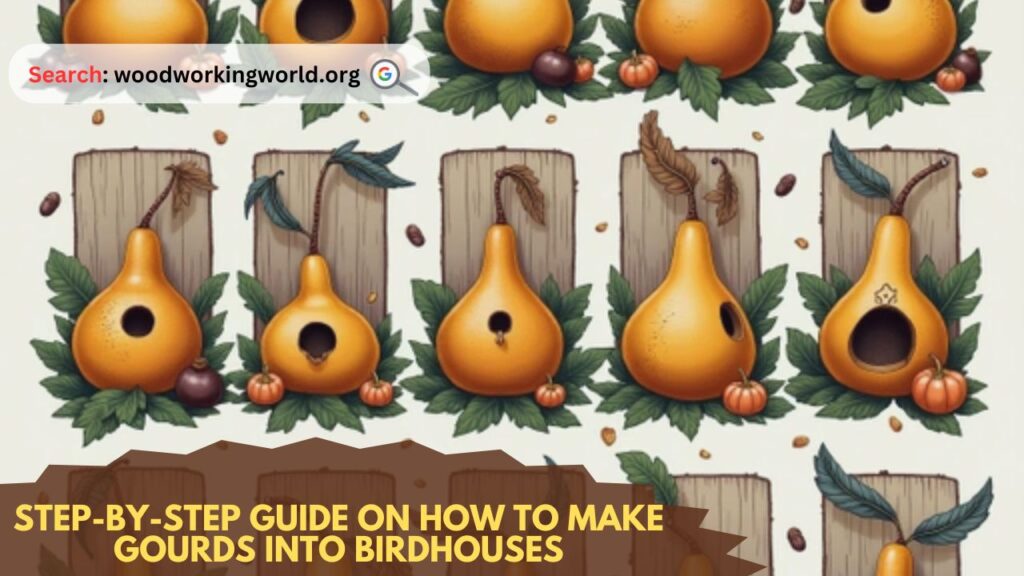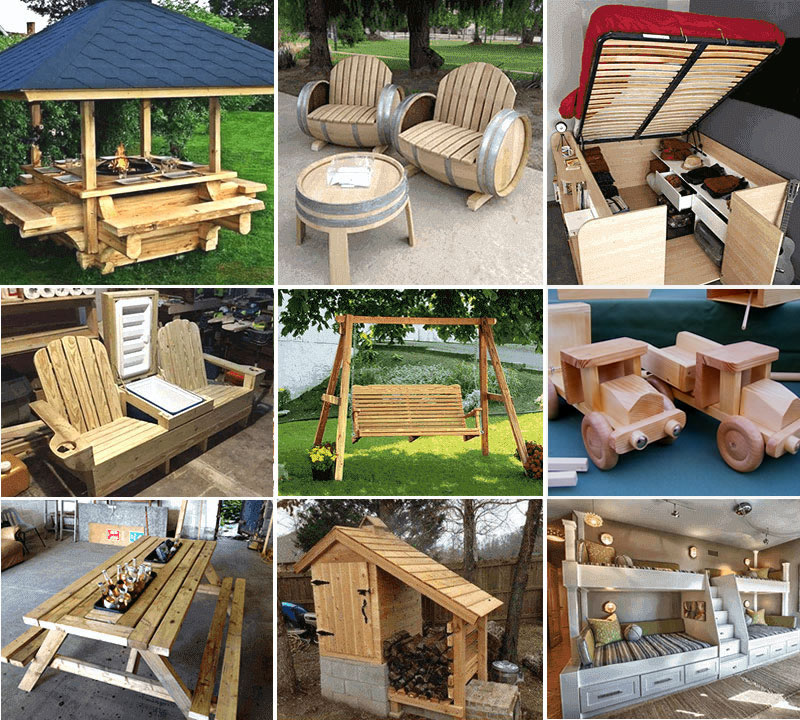Step-by-Step Guide on How to Make Gourds Into Birdhouses
Gourds are a natural, versatile, and sustainable material for creating birdhouses that provide a safe and inviting space for your feathered friends. With a little creativity and some basic tools, you can transform dried gourds into beautiful and functional birdhouses for your garden or backyard.
In this comprehensive, step-by-step guide, we’ll walk you through the entire process—from selecting the right gourds to decorating and hanging your completed birdhouses. By the end, you’ll have all the knowledge needed to create charming gourd birdhouses that will delight birds and enhance your outdoor space.

👉 Click here to unlock 16,000+ DIY woodworking plans now
Why Use Gourds for Birdhouses?
Before diving into the steps, it’s important to understand the advantages of using gourds for birdhouses:
1. Natural and Eco-Friendly
Gourds are a biodegradable and sustainable option that blends beautifully with natural surroundings.
2. Ideal Shape and Size
The hollow interior and round shape of gourds provide a perfect nesting space for small bird species.
3. Durable and Long-Lasting
When properly dried and sealed, gourd birdhouses can withstand outdoor elements for years.
4. Customizable
Gourds can be painted, carved, or decorated to match your garden aesthetic.
Quote: “Creating gourd birdhouses not only benefits birds but also adds a touch of rustic charm to your garden.”
Step 1: Select and Harvest the Right Gourds
The first step is choosing the right type of gourd for your birdhouse project.
Recommended Gourd Varieties:
- Birdhouse Gourds (Lagenaria siceraria): These are the most popular choice due to their ideal size and shape.
- Kettle Gourds: Offer a slightly wider base, suitable for larger birds.
- Cannonball Gourds: Perfect for smaller bird species like wrens and chickadees.
Harvesting Tips:
- Harvest gourds in late fall when the stems turn brown and dry.
- Leave a few inches of stem attached to the gourd to prevent rot.
- Avoid picking gourds that are damaged or show signs of mold.
Step 2: Dry and Cure the Gourds
Proper drying and curing are essential to ensure your gourds are durable and ready for crafting.
Drying Process:
- Clean the Surface: Wipe the gourds with a damp cloth to remove dirt and debris.
- Air Dry: Place the gourds in a well-ventilated, dry area. Ensure they are not touching each other to prevent mold growth.
- Monitor Regularly: Check for signs of rot or mold. Discard any spoiled gourds.
Curing Time:
- Gourds typically take 2 to 3 months to fully dry.
- You’ll know they are ready when they feel light, and the seeds rattle inside.
Tip: Speed up the drying process by placing the gourds near a fan or in a warm, dry location.
Step 3: Prepare the Gourd for Crafting
Once your gourds are dried, it’s time to clean and prepare them for transformation.
Materials Needed:
- Sandpaper (medium and fine grit)
- Bleach solution (1 part bleach to 9 parts water)
- Scrubbing brush
- Gloves
Steps:
- Clean the Exterior: Scrub the surface with a bleach solution to remove any mold or residue.
- Sand the Surface: Use medium-grit sandpaper to smooth rough spots, then switch to fine-grit for a polished finish.
- Cut the Entrance Hole:
- Mark the location for the hole using a pencil.
- Drill or cut a hole using a hole saw attachment.
- Recommended hole sizes:
- Wrens: 1 inch
- Chickadees: 1 1/8 inch
- Bluebirds: 1 1/2 inch
- Remove the Seeds: Shake out loose seeds and debris through the hole.
- Clean the Interior: Use a wire brush or scraper to remove remaining pulp.
Start Your Next Project With Teds’ Archive Of 16,000 Plans!
Instant access to all 16,000 woodworking plans with step-by-step details, photos, materials lists and more
Monthly free plans with lifetime membership access – No renewals, recurring fees or other charges


Step 4: Apply a Protective Finish
Sealing the gourd ensures that your birdhouse can withstand outdoor conditions.
Materials Needed:
- Non-toxic wood sealer or clear polyurethane
- Paintbrush
Steps:
- Apply the Sealant: Coat the exterior and interior of the gourd with a non-toxic sealer.
- Allow to Dry: Let the sealant dry completely before proceeding.
- Optional: Apply a second coat for added protection.
Tip: Avoid using toxic chemicals or strong-smelling sealants that could harm birds.
Step 5: Decorate the Gourd (Optional)
Adding decorations can make your birdhouse a charming addition to your garden.
Decoration Ideas:
- Painting: Use non-toxic, outdoor-safe paints in natural or vibrant colors.
- Carving: Create intricate patterns using a wood-burning tool.
- Stencils: Add floral or geometric designs.
- Natural Elements: Glue on twigs, moss, or bark for a rustic look.
Painting Tips:
- Avoid painting the entrance hole or interior.
- Use a matte or satin finish to reduce glare.
- Seal painted surfaces with a clear, non-toxic topcoat.
Step 6: Install Hanging Hardware
Proper installation ensures that your birdhouse is secure and accessible.
Materials Needed:
- Eye hook or screw
- Drill
- Rope or chain
Steps:
- Drill a Pilot Hole: Create a small hole at the top of the gourd.
- Insert the Eye Hook: Screw the hook securely into the hole.
- Attach Rope or Chain: Ensure the hanging material is strong and weather-resistant.
Step 7: Hang the Birdhouse
Choosing the right location is essential for attracting birds and keeping them safe.
Best Locations:
- Trees: Hang birdhouses from sturdy branches.
- Poles: Mount birdhouses on poles with predator guards.
- Under Eaves: Provide shelter from rain and direct sunlight.
Height Recommendations:
- Wrens and Chickadees: 4 to 6 feet
- Bluebirds: 5 to 7 feet
- Purple Martins: 10 to 15 feet
Tip: Ensure the birdhouse is stable and not swaying excessively.
Step 8: Maintain the Gourd Birdhouse
Regular maintenance keeps the birdhouse clean and safe for future occupants.
Maintenance Tips:
- Clean Annually: Remove old nests and debris at the end of the breeding season.
- Inspect for Damage: Check for cracks or signs of wear.
- Reapply Sealant: Refresh the protective coating as needed.
- Store During Harsh Weather: Bring the birdhouse indoors during extreme winter conditions.

FAQs
1. How long do gourd birdhouses last?
With proper care and maintenance, gourd birdhouses can last several years.
2. Can I use any type of gourd for a birdhouse?
Birdhouse gourds are the best choice due to their size and durability. Other types may work but may not be as suitable.
3. How do I prevent predators from accessing the birdhouse?
Install predator guards and hang the birdhouse at an appropriate height.
4. Can I paint my gourd birdhouse?
Yes, but use non-toxic, weather-resistant paints and avoid painting the interior.
5. What birds are attracted to gourd birdhouses?
Wrens, chickadees, bluebirds, and purple martins are common visitors.
Conclusion
Making gourd birdhouses is a rewarding and creative way to support local bird populations while beautifying your garden. By following these step-by-step instructions and incorporating best practices for maintenance, you’ll create a safe and attractive nesting space that birds will love. So gather your gourds, unleash your creativity, and enjoy the delightful sights and sounds of birds in your backyard.
👉 Click here to unlock 16,000+ DIY woodworking plans now
